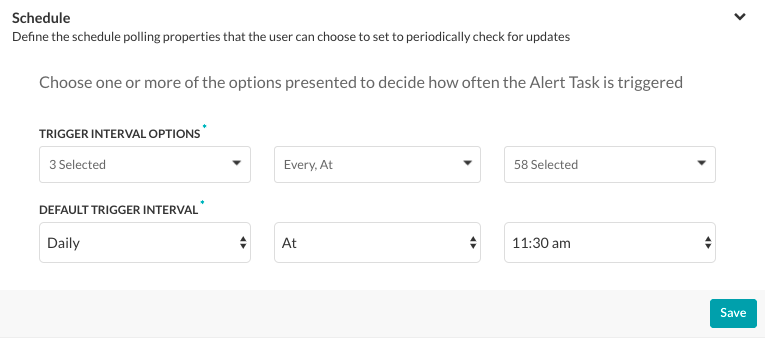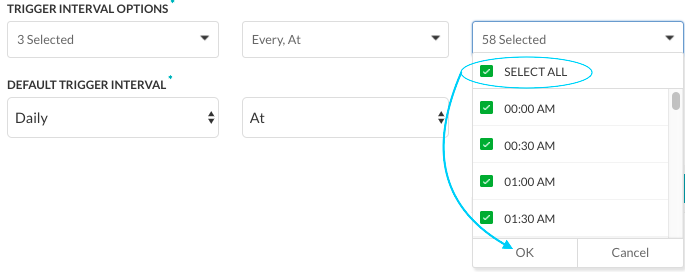여기서 보듯이, 경고 작업은 봇이 요청할 때만 데이터를 위해 웹 서비스에 접근합니다. 각 작업에는, 웹 서비스가 경고 메시지에 대한 데이터를 조회하는 시기와 빈도를 정의해야 합니다. 작업이 설정될 때 최종 사용자에게 표시되는 예약 옵션과 작업을 위한 기본 예약을 정의할 수 있습니다.
작업의 일정 설정하기
웹 서비스에서 데이터를 요청하기 위해 작업이 실행되는 빈도를 위한 기본 설정을 설정해야 합니다. 이 항목에서는 작업 반복을 설정하는 방법을 설명합니다. 작업 실행을 위한 일정 정의를 시작하려면, 다음 그림과 같이 설정 탭의 일정 섹션에서 확장 아이콘을 클릭합니다.

작업의 일정을 설정하려면, 트리거 간격 옵션을 정의한 다음 기본 트리거 간격을 정의해야 합니다. 기본 트리거 간격은 마지막 작업 요청과 다음 자동화된 작업 요청 사이의 경과 시간입니다. 트리거 간격 옵션 섹션에서 최종 사용자에게 표시되는 옵션 설정 방법:
- 첫 번째 필드에서, 매일, 평일, 주말, 각 주의 개별 요일 또는 모두 선택 중 한 가지 이상을 선택한 다음 확인을 클릭합니다.
- 두 번째 필드에서, 매일, 정시 또는 모두 선택 중 한 가지 이상을 선택한 다음 확인을 클릭합니다.
- 세 번째 필드에서, 사용 가능한 5분 간격 또는 30분 시간 슬롯(두 번째 필드가 매일 또는 정시인지 여부에 따라 다름), 모두 선택 중 한 가지 이상을 선택한 다음 확인을 클릭합니다.

